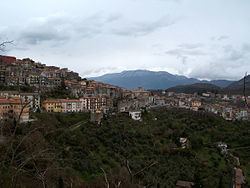Demonym(s) Segnini Dialing code 06 Area 61 km² Postal code 00037 Dialling code 06 | Elevation 668 m (2,192 ft) Time zone CET (UTC+1) Patron saint San Bruno Local time Sunday 5:52 PM | |
 | ||
Weather 14°C, Wind NW at 18 km/h, 49% Humidity Province Metropolitan City of Rome Capital | ||
Segni roma wmv
Segni (in Latin Signia) is an Italian town and comune located in Lazio. The city is situated on a hilltop in the Lepini Mountains, and overlooks the valley of the Sacco River.
Contents
Map of Segni, Rome, Italy
Early history
According to ancient Roman sources, Lucius Tarquinius Superbus, the seventh king of Rome, established a Roman colony at the town, then known as Signia. Additional colonists were reportedly sent there in 495 BC.
The ancient architectural remains at the site date mostly from the Republican period. These include a circuit of fortification walls built using polygonal masonry. The walls incorporated a system of gates, including the Porta Saracena which is covered by a large monolithic architrave. Atop the ancient acropolis of Segni sits the podium of the temple of Juno Moneta, which now supports a Medieval church of Saint Peter (tenth century).
Later history
Segni was a refuge for various popes with Pope Eugene III erecting a palace in the middle of the twelfth century. The Counts of Marsi, hereditary enemies of the Orsini, obtained Segni in the twelfth century. The family called de' Conti produced several popes (Innocent III, Gregory IX and Alexander IV) and many cardinals. In 1558 Segni was sacked by the forces of the Duke of Alba in the war against Pope Paul IV; immense booty was captured, as the inhabitants of the other towns of the Campagna had fled thither. Politician Giulio Andreotti was born in Segni in 1919.
